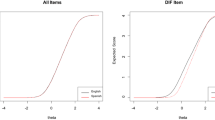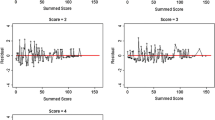Abstract
Purpose
In order to test the difference between group means, the construct measured must have the same meaning for all groups under investigation. This study examined the measurement invariance of responses to the patient-reported outcomes measurement information system (PROMIS) pain behavior (PB) item bank in two samples: the PROMIS calibration sample (Wave 1, N = 426) and a sample recruited from the American Chronic Pain Association (ACPA, N = 750). The ACPA data were collected to increase the number of participants with higher levels of pain.
Methods
Multi-group confirmatory factor analysis (MG-CFA) and two item response theory (IRT)-based differential item functioning (DIF) approaches were employed to evaluate the existence of measurement invariance.
Results
MG-CFA results supported metric invariance of the PROMIS–PB, indicating unstandardized factor loadings with equal across samples. DIF analyses revealed that impact of 6 DIF items was negligible.
Conclusions
Based on the results of both MG-CFA and IRT-based DIF approaches, we recommend retaining the original parameter estimates obtained from the combined samples based on the results of MG-CFA.

Similar content being viewed by others
Abbreviations
- ACPA:
-
American Chronic Pain Association
- CFA:
-
Confirmatory factor analysis
- DIF:
-
Differential item functioning
- IRT:
-
Item response theory
- MG-CFA:
-
Multi-group confirmatory factor analysis
- PB:
-
Pain behavior
- PROMIS:
-
Patient-reported outcomes measurement information system
References
Fordyce, W. E. (1976). Behavioral methods for chronic pain and illness. St. Louis, MO: C. V. Mosby.
Keefe, F. J., Williams, D. A., & Smith, S. J. (2001). Assessment of pain behaviors. In D. C. Turk & R. Melzack (Eds.), Handbook of pain assessment (pp. 170–187). New York, NY: Guilford Press.
Waters, S. J., Dixon, K. E., Keefe, F. J., Ayers, S., Baum, A., McManus, C., et al. (2007). Cambridge handbook of psychology, health and medicine (2nd ed., pp. 300–303). Cambridge UK: Cambridge University Press.
Hadjistavropoulos, T., Herr, K., Turk, D. C., Fine, P. G., Dworkin, R., Helme, R., et al. (2007). An interdisciplinary expert consensus statement on assessment of pain in older persons. The Clinical Journal of Pain, 23(1 Suppl), S1–S43.
Turk, D. C., Dworkin, R. H., Revicki, D. A., Harding, G., Burke, L. B., Cella, D., et al. (2008). Identifying important outcome domains for chronic pain clinical trials: An IMMPACT survey of people with pain. Pain, 137(2), 276–285.
Jensen, M. P. (1997). Validity of self-report and observational measures. In T. S. Jensen & J. A. Turner (Eds.), Proceedings of the 8th world congress on pain: Progress in pain research and management. Seattle, WA: IASP Press.
Cella, D., Riley, W., Stone, A., Rothrock, N., Reeve, B., Yount, S., et al. (2010). Initial item banks and first wave testing of the patient-reported outcomes measurement information system (PROMIS) network: 2005–2008. Journal of Clinical Epidemiology, 63(11), 1179–1194.
Cheung, G. W., & Rensvold, R. B. (1999). Testing factorial invariance across groups: A reconceptualization and proposed new method. Journal of Management, 25(1), 1–27.
Cheung, G. W., & Rensvold, R. B. (2002). Evaluating goodness-of-fit indices for testing measurement invariance. Structural Equation Modeling: A Multidisciplinary Journal, 9(2), 233–255.
French, B. F., & Finch, W. H. (2006). Confirmatory factor analytic procedures for the determination of measurement invariance. Structural Equation Modeling: A Multidisciplinary Journal, 13(3), 378–402.
King, W. C., & Miles, E. W. (1995). A quasi-experimental assessment of the effect of computerizing noncognitive paper-and-pencil measurements: A test of measurement equivalence. Journal of Applied Psychology, 80(6), 643–651.
Vandenberg, R. J., & Lance, C. E. (2000). A review and synthesis of the measurement invariance literature: Suggestions, practices, and recommendations for organizational research. Organizational Research Methods, 3(1), 4–70.
Kline, R. B. (2010). Principles and practice of structural equation modeling (3rd ed.). New York, NY: The Guilford Press.
Stark, S., Chernshenko, O. S., & Drasgow, F. (2006). Detecting differential item functioning with confirmatory factor analysis and item response theory: Toward a unified strategy. Journal of Applied Psychology, 91(6), 1292–1306.
Meade, A. W., & Lautenschlager, G. J. (2004). A comparison of item response theory and confirmatory factor analytic methodologies for establishing measurement equivalence/invariance. Organizational Research Methods, 7(4), 361–388.
Reise, S. P., Widaman, K. F., & Pugh, R. H. (1993). Confirmatory factor analysis and item response theory: Two approaches for exploring measurement. Psychological Bulletin, 114(3), 552–566.
Choi, S. W., Cook, K. F., & Dodd, B. G. (1997). Parameter recovery for the partial credit model using MULTILOG. Journal of Outcome Measurement, 1(2), 114–142.
Meredith, W. (1993). Measurement invariance, factor analysis, and factorial invariance. Psychometrika, 58(4), 525–543.
Horn, J. L., & McArdle, J. J. (1992). A practical and theoretical guide to measurement invariance in aging research. Experimental Aging Research, 18(3), 117–144.
Steenkamp, E. M. J., & Baumgartner, H. (1998). Assessing measurement invariance in cross-national consumer research. Journal of Consumer Research, 25(1), 78–90.
Muthén, L. K., & Muthén, B. O. (1998–2010). Mplus user’s guide (6th ed.). Los Angeles, CA: Muthén & Muthén.
Bentler, P. M. (1980). Multivariate analysis with latent variables: Causal modeling. Annual Review of Psychology, 31(1), 419–456.
Tucker, L. R., & Lewis, C. (1973). A reliability coefficient for maximum likelihood factor analysis. Psychometrika, 38(1), 1–10.
Byrne, B. M. (1998). Structural equation modeling with LISREL, PRELIS, and SIMPLIS. Hillsdale, NJ: Lawrence Erlbaum.
Steiger, J. H., & Lind, J. C. (1980). Statistically-based tests for the number of common factors. In Paper presented at the annual spring meeting of the Psychometric Society, Iowa City, IA.
Woehr, D. J., Arciniega, L. M., & Lim, D. H. (2007). Examining work ethic across populations. A comparison of the multidimensional work ethic profile across three diverse cultures. Educational and Psychological Measurement, 67(1), 154–168.
Browne, M., & Cudeck, R. (1993). Alternative ways of assessing model fit. In K. Bollen & J. Long (Eds.), Testing structural equation models (pp. 136–162). London, England: Sage.
Hu, L., & Bentler, P. M. (1999). Cutoff criteria for fit indexes in covariance structure analysis: Conventional criteria versus new alternatives. Structural Equation Modeling: A Multidisciplinary Journal, 6(1), 1–55.
Marsh, H. W., Hau, K., & Wen, Z. (2004). In search of golden rules: Comment on hypothesis-testing approaches to setting cutoff values for fit indexes and dangers in overgeneralizing Hu and Bentler’s (1999) findings. Structural Equation Modeling: A Multidisciplinary Journal, 11(3), 320–341.
Sivo, S. A., Fan, X., Witta, E. L., & Willse, J. T. (2006). The search for “optimal” cutoff properties: Fit index criteria in structural equation modeling. The Journal of Experimental Education, 74(3), 267–288.
Choi, S. W., Gibbons, L., & Crane, P. K. (2011). Lordif: An R package for detecting differential item functioning using iterative hybrid ordinal logistic regression/item response theory and Monte Carlo simulations. Journal of Statistical Software, 39(8), 1–30.
Crane, P. K., Gibbons, L. E., Jolley, L., & van Belle, G. (2006). Differential item functioning analysis with ordinal logistic regression techniques: DIFdetect and difwithpar. Medical Care, 44(Suppl 3), S115–S123.
Zumbo, B. D. (1999). A handbook on the theory and methods of differential item functioning (DIF): Logistic regression modeling as a unitary framework for binary and Likert type (ordinal) item scores. Ottawa, ON: Directorate of Human Resources Research and Evaluation Department of National Defense.
Crane, P. K., Van Belle, G., & Larson, E. B. (2004). Test bias in a cognitive test: Differential item functioning in the CASI. Statistics in Medicine, 23(2), 241–256.
Crane, P. K., Gibbons, L., Ocepek-Weiklson, K., Cook, K., Cella, D., Narasimhalu, K., et al. (2007). A comparison of three sets of criteria for determining the presence of differential item functioning using ordinal logistic regression. Quality of Life Research, 16(Suppl 1), 69–84.
Cook, K. F., Bombardier, C. H., Bamer, A. M., Choi, S. W., Kroenke, K., & Fann, J. R. (2011). Do somatic and cognitive symptoms of traumatic brain injury confound depression screening?. Archives of Physical Medicine and Rehabilitation, 92, 818–823.
Revicki, D. A., Chen, W., Harnam, N., Cook, K. F., Amtmann, D., Callahan, L. F., et al. (2009). Development and psychometric analysis of the PROMIS pain behavior item bank. Pain, 146(1–2), 158–169.
Liu, H. H., Cella, D., Gershon, R., Shen, J., Morales, L. S., Riley, W., et al. (2010). Representativeness of the PROMIS internet panel. Journal of Clinical Epidemiology, 63(11), 1169–1178.
Cook, K. F., Teal, C. R., Bjorner, J. B., Cella, D., Chang, C. H., Crane, P. K., et al. (2007). IRT health outcomes data analysis project: An overview and summary. Quality of Life Research, 16(Suppl 1), 121–132.
Chen, F. F., Sousa, K. H., & West, S. G. (2005). Testing measurement invariance of second-order factor models. Structural Equation Modeling: A Multidisciplinary Journal, 12(3), 471–492.
Yen, W. M. (1993). Scaling performance assessments: Strategies for managing local item dependence. Journal of Educational Measurement, 30(3), 187–213.
Steinberg, L., & Thissen, D. (1996). Uses of item response theory and the testlet concept in the measurement of psychopathology. Psychological Methods, 1(1), 81–97.
Acknowledgments
The project described was supported by Award Number 3U01AR052177-06S1 from the National Institute of Arthritis and Musculoskeletal and Skin Diseases. The content is solely the responsibility of the authors and does not necessarily represent the official views of the National Institute of Arthritis and Musculoskeletal and Skin Diseases or the National Institutes of Health.
Author information
Authors and Affiliations
Corresponding author
Rights and permissions
About this article
Cite this article
Chung, H., Kim, J., Cook, K.F. et al. Testing measurement invariance of the patient-reported outcomes measurement information system pain behaviors score between the US general population sample and a sample of individuals with chronic pain. Qual Life Res 23, 239–244 (2014). https://doi.org/10.1007/s11136-013-0463-0
Accepted:
Published:
Issue Date:
DOI: https://doi.org/10.1007/s11136-013-0463-0




